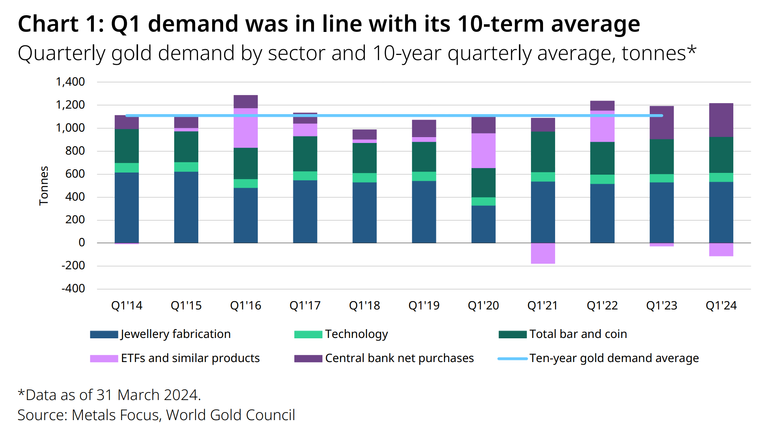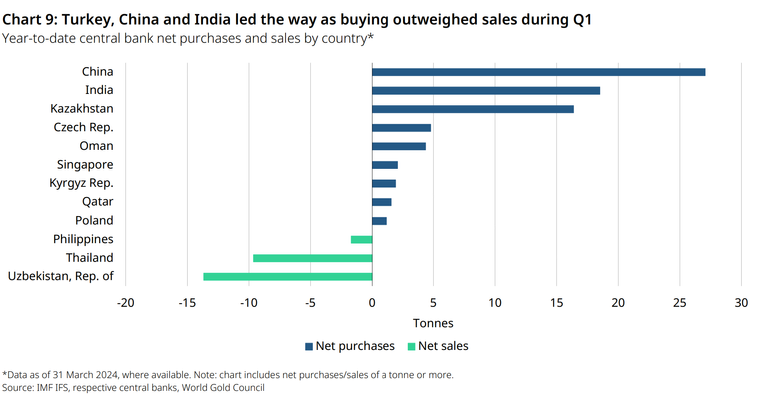SPOT MARKET IS OPEN (WILL CLOSE IN 6 HRS. 25 MINS. )
Live Spot Gold
Bid/Ask
2,298.402,299.40
Low/High
2,296.202,329.70
Change
-36.90-1.58%
30daychg
+65.40+2.93%
1yearchg
+312.00+15.71%
Silver Price & PGMs

(Kitco News, Tues. April 30th. 2024) – The gold market saw its best start to the year since 2016 as robust Asian demand and record central bank purchases dominate the marketplace, according to the latest report from the World Gold Council.
Tuesday, the WGC released its first quarter Gold Demand Trends report, saying that, including Over-the-Counter purchases, global physical gold demand rose to 1,238 tonnes, an increase of 3% from the first quarter of 2023. Excluding the OTC market, the WGC said that gold demand dropped by 5% to 1,102 tonnes due to continued outflows in gold-backed exchange-traded funds.

In an interview with Kitco News, Juan Carlos Artigas, Head of Global Research at the WGC, said that while the OTC market can be pretty opaque, the current data strongly suggests that demand continues to come from Asian consumers, led by Chinese investors.
“There is strong anecdotal evidence and other data that points to the fact that there is strong demand in Asia, but it’s happening more in the OTC market,” he said. “Asian consumers have been coming with a lot of force into the gold market.”
Looking at small bar and coin demand, the WGC said China saw the strongest quarter since 2017.
“With improving household wallets, the positive example set by continued central bank demand, a poor domestic equity, and property market and currency fragility, the conditions are in place for demand to continue at solid levels,” the WGC analysts said in the report.
Artigas pointed out that Asian demand has impacted all aspects of the gold market, from healthy jewelry demand to investment inflows into exchange-traded funds to OTC markets. Artigas also noted that the WGC has seen significant growth in relatively small Chinese future markets.
Artigas explained that Chinese investors remain heavily focused on gold and are trying to get any type of exposure.
Although Asian demand has a firm hold on the market, Artigas explained that the market is far from saturated even in the current environment.
“People are trying to figure out where in the cycle we are; the market still has room to grow, especially amongst Western investors,” he said.
Central Banks remain voracious gold buyers

One specific area of growth for gold remains central bank demand. The WGC said that central bank net demand totaled 290 tonnes in the first quarter – the strongest start to any year on record.
While retail and investment demand could be sensitive to higher gold prices, Artigas noted that price is not the main factor for central banks as they continue to diversify their foreign reserves.
“Gold has proven to be a very powerful diversifier, and that is one of the key reasons that central banks themselves cite us as the reason for holding it,” said Artigas.
Although generalist investors are only just now starting to pay attention to central bank demand, Artigas noted that this trend has been in place for more than a decade. He added that there are no indications that central banks’ appetites have been sated yet.
“When the only reserve currency is the dollar, that can sometimes create constraints for some trading partners. And when you have a foreign reserve, such as gold, that doesn’t carry any counterparty risk, that can provide a sense of trust. Holding some gold can be very beneficial for these countries,” he said.
Although the WGC expects central banks to remain healthy net gold buyers this year, the analysts note that higher prices could create a more two-way market.
“The multi-year trend of net central bank buying appears established, but there may well be some central banks willing to wait on the sidelines in response to the recent price surge. Equally, opportunistic sellers may be more likely to get drawn out with the stellar rise in prices so far this year,” the analysts said in the report.
Retail consumers buying gold, but investment demand remains lukewarm
The significant weak pillar in the gold market remains investor demand for gold-backed exchange-traded funds. The report said that global Gold ETFs saw their holdings falling by 114 tonnes in the first quarter of the year. The exodus continues to be led by North American and European funds and was slightly offset by inflows into Asian-listed products.
Artigas said that higher interest rates continue to create a challenging environment for gold as investors are seeing positive real yields in global bond markets.
However , “ 5% yields do not tackle the problem of real rates return compared to the 30% rise in gas & groceries for Americans, which by the way are excluded from the CPI used to measure U.S. inflation.” says Jack Dempsey, President of 401 Gold Consultants LLC.
Additionally, “The US has shown a glimmer of hope during April, but rate cuts might be needed to help trigger sustained inflows. Sticky inflation and labour market strength suggest there will be a bit of a wait,” the WGC analysts said.
Higher prices weigh on jewelry demand, but the trend remains well above average
The one sector in the gold market that has struggled in the first three months of 2024, as prices held above $2,000 an ounce, has been jewelry demand. Jewelry demand has seen an even further slowdown as gold’s breakout rally to record highs above $2,400 an ounce happened in the final month of the quarter.
In total, the WGC said that global demand for gold jewelry in the first quarter came in at 479 tonnes, down 2% from last year. However, looking at the long-term trend, first-quarter jewelry purchases were roughly 3% above the first-quarter average from the past five years of 465 tonnes.
Looking at Chinese demand, the WGC said gold jewelry purchases totaled 184 tonnes in Q1 – down 65 compared to a very strong Q1’23.
“Nevertheless, demand was 13% above the ten-year average of 162t as demand held broadly in line with levels that were typical in the years prior to the pandemic,” the report said.
However, Eastern jewelry demand was well supported by Indian consumers. The WGC said Indian jewelry purchases in the first quarter were 95 tonnes, 4% above the comparatively weak Q1’23.
“India’s continued strong macroeconomic environment was supportive of gold consumption. Rural demand is now seeing similar growth to that of urban India; in recent quarters, it lagged behind as it struggled to shake off the effects of the pandemic,” the analysts said in the report.
Looking at Western jewelry demand, the U.S. market fell to 25 tonnes, a modest 2% from last year. The WGC said this was the eighth consecutive year-over-year decline as gold jewelry consumption continued to ‘normalize following the bumper years produced by the pandemic.
At the same time, European jewelry purchases edged lower in the first quarter, declining by 2% year-over-year to 11 tonnes.
One area of surprising growth in the gold market was in technical applications. The WGC said that demand from the tech sector grew to 79 tonnes, a 10% jump from last year.
“ This was driven by supply chain restocking and emerging AI-related opportunities. Overall, technology demand is expected to continue its upward trend throughout the year,” the analysts said.
On the supply side, the WGC said mine production increased 4% year-on-year to 893 tonnes – a record first quarter. Recycling also reached the highest level since Q3 2020, jumping 12% year-over-year to 351 tonnes, as higher prices were an opportunity for some to cash in on their old gold jewelry
Posted by:
Jack Dempsey, President
401 Gold Consultants

